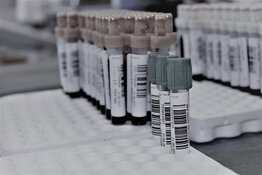The Life Sciences Report: Greg, you are coming off of a pretty good year. Congratulations on that. I realize that 2012 was a good year in general for biotech. What was that about?
Greg Wade: It was about the healthy financing we saw throughout the year, which was facilitated by a couple of factors. A widespread decline in volatility globally in the marketplace was notable. Low volatility creates healthy financing environments. Risk capital was seeking an environment where growth could be generated against a backdrop of global economic uncertainty. That made healthcare an attractive place for investors to put money to work.
TLSR: Given that general wave of biotech in 2012, will that work for investors in 2013?
GW: This year seems to be starting out the way 2012 went. The index seems stable. We haven't seen any significant big moves, either in large or small caps. It's still early in the year, but the overall market has been pretty calm. We've seen a lot of financing activity, which is an ongoing positive. Money is being put to work in healthcare stocks, and we are optimistic that will continue. We are also seeing evidence that private companies will try to address the public markets. That is continued evidence of investors' belief that there is going to be strength in this group throughout the year. Yes, 2013 is starting out very strongly.
TLSR: Do you think initial public offerings (IPOs) will return to their former prominence in biotechnology?
GW: I'm not sure. We've had a healthy amount of IPO activity over the last couple of years, and they have been priced at levels that have ensured the best opportunities for investors to do well. But I don't expect we will see the feasts and famines of the more distant past. There will continue to be a healthy flow of good companies attractively priced for investors.
TLSR: Do you see a rotation out of certain disease indications into new ones?
GW: No. I don't know that our clients are picking segments of the marketplace. Most of the professional investors looking at the companies we cover are stock pickers. They're picking ideas that they think can work in the short and long term based on the company's merits versus an overall thematic idea.
TLSR: Would tell me some of the names that you like?
GW: I'll start with Oncolytics Biotech Inc. (ONCY:NASDAQ; ONC:TSX). Some interesting data were reported on Dec. 13, and the year finished with the company deciding that its phase 3 head-and-neck cancer trial, REO 018 (Reolysin [reovirus serotype 3—Dearing strain] in combination with carboplatin and paclitaxel in second-line patients with platinum-refractory, taxane-naïve head-and-neck cancers), has been effectively split into two different studies. One side focuses on patients with distal metastatic disease, and the other on those with locoregional recurrence, with or without distant metastatic disease. Data for progression-free survival and overall survival is expected in Q2/13.
"Money is being put to work in healthcare stocks, and we are optimistic that will continue."
Subsequently, some initial analysis was completed that suggested a positive differential effect on tumor size, and on the percentage of patients with a positive result, at an early point in the experimental arm of the study. It is a somewhat novel analysis, and because it was double-blinded, randomized data, I think it caused investors to be enthusiastic about the potential that this was an early indication of the drug working. This was actually the first endpoint to be un-blinded in REO 018.
Now we are a quarter or so away from release of important information from the phase 3 trial, which we are expecting in Q2/13. We continue to be encouraged by the potential for the drug and are very eager to see how this phase 3 study turns out.
TLSR: It's an interesting idea to look at the effect of Reolysin on distal metastatic lesions versus those that may not have metastasized as yet. These tumor colonies have different phenotypes. Do you think that's a good design?
GW: Anything that can be done to make a more homogeneous study population is likely to assist in discerning a difference. If you have an inhomogeneous group of folks, there may be important differences that aren't notable across the breadth of that group. I think this is an appropriate way to improve the chance of success for the study.
TLSR: When we spoke last, in August, we talked briefly about the difficulty of this squamous cell carcinoma of the head-and-neck indication. It is so aggressive and generally difficult to deal with, both medically and surgically. It is disfiguring, and patients lose their ability to eat. I say any progress or improvement in efficacy is good. But these recent data, while statistically significant, aren't dramatic. How will Reolysin stack up against cetuximab (Erbitux)? Does it have to show superiority or just noninferiority?
GW: We won't be able to do a direct comparison because they are different studies. There is no reason to believe that Oncolytics' approach would be exclusive of cetuximab. For investors, it is about getting that first randomized data showing that there is a treatment effect, because we believe that the disease indication and market opportunity are very broad for Reolysin. We are not going to hold up a glass right now to see whether it's better or worse than cetuximab, although some investors might look at that as being important relative to the opportunity in head-and-neck cancer treatments.
TLSR: These clinical trials with Reolysin are so numerous. It looks like maybe 30 trials are going on in the U.S., in Canada and in the U.K. How is the company funding all of these?
GW: A number of the ongoing studies for Reolysin are being sponsored by the National Cancer Institute. That is offsetting a tremendous amount of the cost. I believe about 10 studies are sponsored.
TLSR: Is the phase 3 data on Reolysin the next catalyst for Oncolytics? And what is your target price?
GW: Yes, that is the next catalyst. We expect data in Q2/13: It might slip into Q3. My target price is $11.
TLSR: That's where your target price was when we spoke in August. Can you talk about another name?
GW: We had hoped that Addex Therapeutics (ADXN:SIX; ADDXF:OTCBB) would have entered into a partnership by the end of 2012 for dipraglurant, which is for Parkinson's disease levodopa-induced dyskinesia (PD-LID). We are now a little ways into 2013 and haven't seen anything yet. It's uncertain as to whether Addex was overly optimistic, or whether the company will try to drive the product forward to the next value inflection point without a partner. It's a wait-and-see situation at this time.
TLSR: The next catalyst for Addex would be partnering dipraglurant. Is that right?
GW: Yes. I think that a potential partnership—or further phase 2 work conducted on the company's behalf with the product—are the next likely catalysts.
TLSR: Could you go ahead and choose another company to talk about?
GW: We are very enthusiastic about Endocyte Inc. (ECYT:NASDAQ) for 2013. The company has a folic acid-targeted chemotherapy construct, vintafolide, in a phase 3 study (the PROCEED trial) for platinum-resistant ovarian cancer. A readout is expected in H1/14. It has a non-small cell lung cancer study in phase 2 with that same drug. Again, that should read out in H1/14. Toward the end of this year, we should learn whether or not the company has been successful with its application for early approval in Europe. It is fortunate to have $200 million ($200M) plus on its balance sheet as a result of the Merck & Co. Inc. (MRK:NYSE) deal with vintafolide announced in April 2012. We will also probably get some insight into its pipeline this year.
TLSR: Another company?
GW: Pharmacyclics Inc. (PCYC:NASDAQ) continues to be on our Best Ideas list. Following the American Society of Hematology (ASH) meeting in early December, we raised our price target from $70 to $110 per share. The stock is solidly through $70 now, having pulled back a little bit after ASH to the high 50s.
"There will continue to be a healthy flow of good companies attractively priced for investors."
We believe that investors need to own Pharmacyclics, as we are expecting its Bruton's tyrosine kinase inhibitor, ibrutinib, to be one of the biggest hematology/oncology drugs ever. The value here is in the chronic administration of the drug to patients with chronic lymphocytic leukemia (CLL). That is what has us and others so focused on the company. We expect this stock to work ahead of what we believe will be an early stoppage of the ibrutinib versus ofatumumab study, which we are projecting could happen in the first part of 2014.
TLSR: Ofatumumab implies B-cell disease and B-cell blockade. Is this drug going to be tested in all of the old indications that rituximab (Rituxan; Genentech USA Inc./Biogen Idec Inc. (BIBB:NASDAQ)) was developed for originally?
GW: It has shown some activity in a number of them. I don't actually have a breakdown of where Rituxan was used, but CLL will be the most important indication.
TLSR: Go ahead to your next idea.
GW: Insmed Inc. (INSM:NASDAQ) has some very important data coming out. Its product Arikace is an inhaled liposomal formulation of the aminoglycoside antibiotic amikacin, and is in phase 3 for Pseudomonas aeruginosa lung infections in patients with cystic fibrosis (CF). It is in phase 2 for patients with nontuberculosis mycobacterial (NTM) lung infections. The liposome formulation penetrates the sputum in these patients, and amikacin is an approved antibiotic known already to be potent against gram-negative infections.
TLSR: When can we expect some catalyst data?
GW: The CF data are expected in the middle of 2013. The phase 2 results would suggest the potential for a superior level of efficacy to tobramycin, another aminoglycoside used in these indications. That would be attractive to patients and clinicians. Then, in the latter part of the year, the data from the NTM study should be available. If we are right, and it shows superiority in the CF setting, then we think a new drug application for Arikace potentially could be filed with the FDA. If the NTM indication subsequently shows positive phase 2 data, that market opportunity could open up.
TLSR: Your next idea?
GW: Anacor Pharmaceuticals Inc. (ANAC:NASDAQ) has announced statistically significant results for tavaborole for treatment of onychomycosis (fungal nail infections). However, top-line comparison with Valeant Pharmaceuticals International Inc.'s (VRX:NYSE; VRX:TSX) efinaconazole didn't impress investors. Importantly, the tavaborole control results suggest to us that this was a much more refractory patient population. We see merit in the data that leads us to continue to believe that tavaborole will be a successful product in onychomycosis.
TLSR: If efinaconazole is approved, you expect approval for tavaborole as well?
GW: We have the efinaconazole data in hand now, so we can see its efficacy. A well-understood set of data will be required for tavaborole approval, so the results of Anacor's phase 3 study will matter. But we don't see any barrier to approval if it shows statistical significance in phase 3.
TLSR: These are both topical products. That's of value because dermatologists hate to give patients ketoconazole and the hepatotoxic (toxic to the liver) agents that followed. Are the topical agents going to be prescription products?
GW: Yes. We expect they will be prescription for the time being.
TLSR: What can you charge patients for these topical medications?
GW: It wouldn't be surprising to us if the cost of therapy was between $70–100 a month.
TLSR: I'm thinking the patient will use these products for a year, is that right?
GW: Yes. The phase 3 studies for both the Valeant product and Anacor's employed a 48-week duration of therapy. It takes about 12 months for the toenail to grow out, so clinicians want to continue to treat to ensure the growth of a clear nail. Patients will treat themselves, with some variability in timeframe.
TLSR: Let's say the patient, or the patient's insurer, spends $1,000 per year for this. Could these be billion-dollar products?
GW: Absolutely. There are 35M people in the U.S. alone with toenail fungus. It doesn't take very many market share points to project large, large numbers.
TLSR: Anacor has a market cap of less than $200M. That portends a very nice bump.
GW: We're hopeful.
TLSR: Can you mention another one?
GW: SIGA Technologies Inc. (SIGA:NASDAQ) has been a choppy stock. It has argued its case before the Delaware Supreme Court that a lower court judge erred in ruling that SIGA must share profits from its smallpox antiviral drug, ST-246 (tecovirimat), now branded Arestvyr, 50/50 with PharmAthene Inc. (PIP:NYSE) after SIGA's first $40M of net profits. We would expect the Delaware Supreme Court to rule on that appeal sometime before the middle of April. We don't see any likelihood that SIGA's position in the dispute would worsen, so it seems to us that there's only neutral to upside reaction possible following the Supreme Court ruling. That, combined with the fact that the company will start shipping its product into the U.S. government's strategic national stockpile in the earlier part of 2013 and begin recording real revenue in the middle of the year, makes this a really interesting stock at the moment.
TLSR: And that decision will come down in mid-April?
GW: Yes. Courts typically render their decisions within 90 days of the oral arguments. So we don't expect it will drag out longer than mid-April.
TLSR: We spoke about Zalicus Inc. (ZLCS:NASDAQ) back in August. It sold off and was cut in half after its drug Synavive missed its secondary endpoint in a phase 2b trial for rheumatoid arthritis. You cut your target price from $5 to $3, which still represents almost a 400% implied return from current levels. What is the Zalicus story about now?
GW: Now it's about the company's two oral drug pain programs, Z160, an N-type calcium channel blocker in phase 2, and Z944, a T-type calcium channel blocker in phase 1. What we're looking for is the first efficacy data for Z160 in its two pain settings—lower back pain and postherpetic neuralgia (PHN). We are very excited by the opportunity for Z160. To have a novel, non-narcotic pain therapy is very desirable. We're all aware of the limitations in terms of the narcotics—addictions, interactions with alcohol, constipation, sedation—so to have a potent pain therapy without those side effects would be tremendous for patients who live with chronic pain or have acute pain. But Zalicus must get good data from these two studies. Pain studies have been tricky.
TLSR: Who are the patients for Z160?
GW: There are two types of PHN. One is chronic, and the other is transient PHN that comes with a recurrence of the chicken pox virus. The other setting is in lower back pain.
TLSR: Best wishes, Greg. Thank you so much.
GW: Thank you very much. I enjoyed it.
Greg Wade, managing director and senior analyst with Wedbush Securities, earned an undergraduate degree with honors in medical biophysics and a doctorate in physiology from the University of Western Ontario in London, Canada. He has worked on the sellside since early 2000, first at Pacific Growth Equities and subsequently at Wedbush PacGrow LifeSciences, where he was promoted to managing director in 2011. Wade's coverage of emerging biopharmaceutical companies is supported by analyst team members David Nierengarten and Chris Marai.
DISCLOSURE:
1) George S. Mack of The Life Sciences Report conducted this interview. He personally and/or his family own shares of the following companies mentioned in this interview: None.
2) The following companies mentioned in the interview are sponsors of The Life Sciences Report: Oncolytics Biotech Inc., Addex Therapeutics Ltd. Merck & Co. Inc. is not affiliated with Streetwise Reports. Streetwise Reports does not accept stock in exchange for services. Interviews are edited for clarity.
3) Greg Wade: I personally and/or my family own shares of the following companies mentioned in this interview: Pharmacyclics Inc., SIGA Technologies Inc., Zalicus Inc. I personally and/or my family am paid by the following companies mentioned in this interview: None. I was not paid by Streetwise Reports for participating in this interview.

 The driving principle behind successful biotech investment for Managing Director and Senior Analyst Greg Wade of Wedbush Securities is to find companies with clinical assets that are of value to patients and hence to the marketplace. In this interview with
The driving principle behind successful biotech investment for Managing Director and Senior Analyst Greg Wade of Wedbush Securities is to find companies with clinical assets that are of value to patients and hence to the marketplace. In this interview with 







































